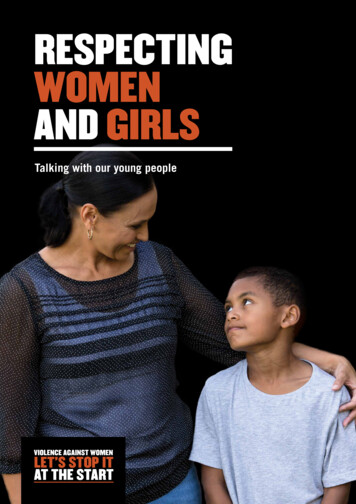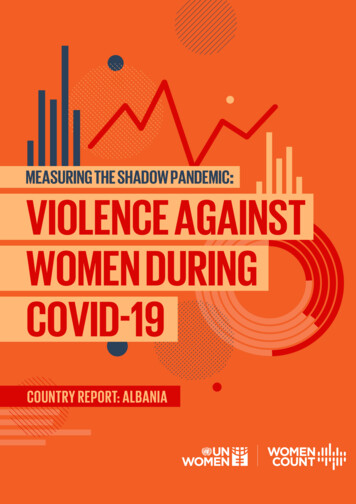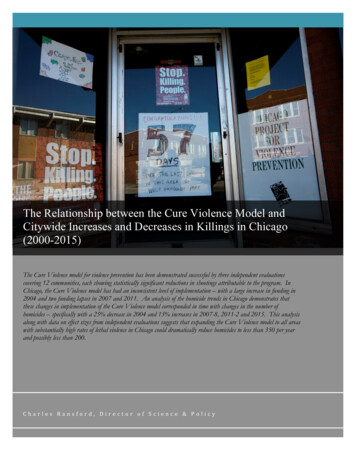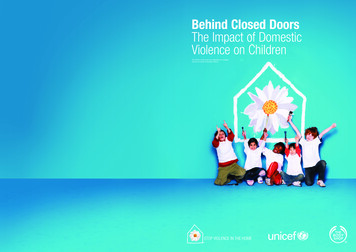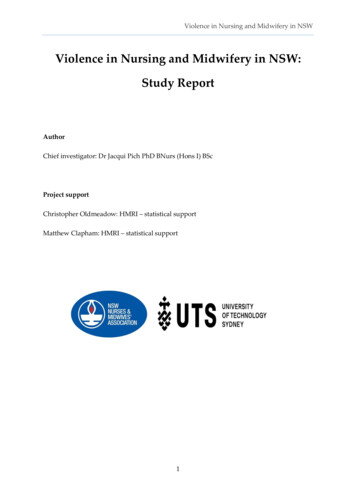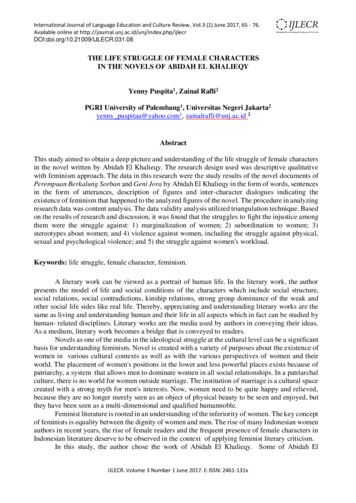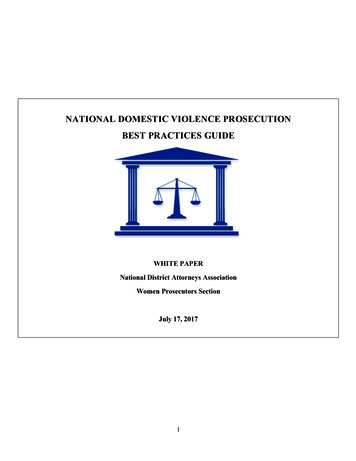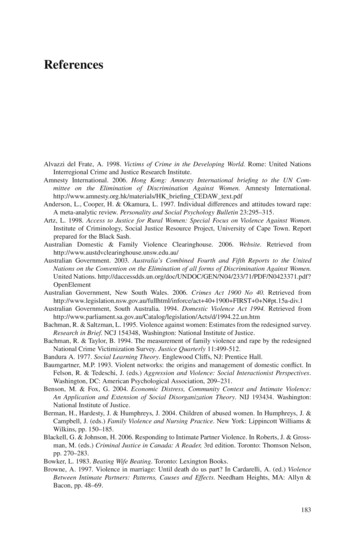
Transcription
ReferencesAlvazzi del Frate, A. 1998. Victims of Crime in the Developing World. Rome: United NationsInterregional Crime and Justice Research Institute.Amnesty International. 2006. Hong Kong: Amnesty International briefing to the UN Committee on the Elimination of Discrimination Against Women. Amnesty HK briefing CEDAW text.pdfAnderson, L., Cooper, H. & Okamura, L. 1997. Individual differences and attitudes toward rape:A meta-analytic review. Personality and Social Psychology Bulletin 23:295–315.Artz, L. 1998. Access to Justice for Rural Women: Special Focus on Violence Against Women.Institute of Criminology, Social Justice Resource Project, University of Cape Town. Reportprepared for the Black Sash.Australian Domestic & Family Violence Clearinghouse. 2006. Website. Retrieved tralian Government. 2003. Australia’s Combined Fourth and Fifth Reports to the UnitedNations on the Convention on the Elimination of all forms of Discrimination Against Women.United Nations. PDF/N0423371.pdf?OpenElementAustralian Government, New South Wales. 2006. Crimes Act 1900 No 40. Retrieved orce/act 40 1900 FIRST 0 N#pt.15a-div.1Australian Government, South Australia. 1994. Domestic Violence Act 1994. Retrieved ation/Acts/d/1994.22.un.htmBachman, R. & Saltzman, L. 1995. Violence against women: Estimates from the redesigned survey.Research in Brief. NCJ 154348, Washington: National Institute of Justice.Bachman, R. & Taylor, B. 1994. The measurement of family violence and rape by the redesignedNational Crime Victimization Survey. Justice Quarterly 11:499-512.Bandura A. 1977. Social Learning Theory. Englewood Cliffs, NJ: Prentice Hall.Baumgartner, M.P. 1993. Violent networks: the origins and management of domestic conflict. InFelson, R. & Tedeschi, J. (eds.) Aggression and Violence: Social Interactionist Perspectives.Washington, DC: American Psychological Association, 209–231.Benson, M. & Fox, G. 2004. Economic Distress, Community Context and Intimate Violence:An Application and Extension of Social Disorganization Theory. NIJ 193434. Washington:National Institute of Justice.Berman, H., Hardesty, J. & Humphreys, J. 2004. Children of abused women. In Humphreys, J. &Campbell, J. (eds.) Family Violence and Nursing Practice. New York: Lippincott Williams &Wilkins, pp. 150–185.Blackell, G. & Johnson, H. 2006. Responding to Intimate Partner Violence. In Roberts, J. & Grossman, M. (eds.) Criminal Justice in Canada: A Reader, 3rd edition. Toronto: Thomson Nelson,pp. 270–283.Bowker, L. 1983. Beating Wife Beating. Toronto: Lexington Books.Browne, A. 1997. Violence in marriage: Until death do us part? In Cardarelli, A. (ed.) ViolenceBetween Intimate Partners: Patterns, Causes and Effects. Needham Heights, MA: Allyn &Bacon, pp. 48–69.183
184ReferencesBrownridge, D. & Halli, S. 2001. Explaining Violence Against Women in Canada. New York:Lexington Books.Burt, M. 1991. Rape myths and acquaintance rape. In Parrot, A. & Bechhofer, L. (ed.) Acquaintance Rape: The Hidden Crime. New York: John Wiley & Sons, pp. 26–40.Campbell, J. 2002. Health consequences of intimate partner violence. Lancet 359:1331–1336.Campbell, J., Garcia-Moreno, C. & Sharps, P. 2004. Abuse during pregnancy in industrialized anddeveloping countries. Violence Against Women 10(7):770–789.Campbell, J. & Lewandowski, L. 1997. Mental and physical health effects of intimate partnerviolence on women and children. Psychiatric Clinics of North America 20(2):353–374.Campbell, J., Sharps, P. & Glass, N. 2001. Risk assessment for intimate partner homicide. InPinard, G. & Pagani, L. (eds.) Clinical Assessment of Dangerousness: Empirical Contributions.New York: Cambridge, pp. 136–157.Campbell, J., Snow Jones, A., Dienemann, J., Kub, J., Schollenberger, J., O’Campo, P.,Carlson Gielen, A., Wynne, C. 2002. Intimate partner violence and physical health consequences. Archives of Internal Medicine 162:1157–1163.Campbell, J. & Soeken, K. 1999. Forced sex and intimate partner violence: Effects on women’srisk and women’s health. Violence Against Women. 5(9):1017–1035.Campbell, J., Torres, S., Smith McKenna, L., Sheridan, D. & Landenburger, K. 2004. Nursingcare of survivors of intimate partner violence. In Humphreys, J. & Campbell, J. (eds.) FamilyViolence and Nursing Practice. New York: Lippincott Williams & Wilkins, pp. 307–360.Campbell, J., Webster, D. & Koziol-McLain, J., et al. 2003. Risk factors for femicide in abusiverelationships: Results from a multisite case control study. American Journal of Public Health93:1089–1097.Campbell, R. & Raja, S. 1999. Secondary victimization of rape victims: Insights from mentalhealth professionals who treat survivors of violence. Violence and Victims 4(3): 261–275.Campbell, R., Wasco, S., Ahrens, C., Sefl, T. & Barnes, H. 2001. Preventing the “second rape”:Rape survivors’ experiences with community service providers. Journal of Interpersonal Violence 16(12):1239–1259.Cantor, D. & Lynch, J. 2000. Self-report surveys as measures of crime and criminal victimization.Measurement and Analysis of Crime and Justice: Criminal Justice 2000, Vol. 4. Washington:U.S. Department of Justice, pp. 85–138.Check, J. & Malamuth, N. 1985. An empirical assessment of some feminist hypotheses about rape.International Journal of Women Studies 8(4):414–423.Chodorow, N. 1974. Family structure and feminine personality. In Rosaldo, M. & Lamphere, L.(eds.) Women, Culture and Society. Stanford, CT: Stanford University Press, pp. 43–66.Cohen, L. & Felson, M. 1979. Social change and crime rate trends: A routine activity approach.American Sociological Review. 44: 588–608.Coker, A., Smith, P., Bethea, L., King, M. & McKeown, R. 2005. Physical health consequencesof physical and psychological intimate partner violence. Archives of Family Medicine 9:451–457.Connors, J. 2000. United Nations Work on Violence Against Women. Unpublished presentationgiven at the Tenth International Symposium on Victimology, Montreal, August6–11.Coulter, M., Kuehnle, K., Byers, R. & Alfonso, M. 1999. Police-reporting behaviour and victimpolice interactions as described by women in a domestic violence shelter. Journal of Interpersonal Violence 14(12):1290–1298.Counts, D., Brown, J. & Campbell, J. (eds.) 1992. Sanctions and Sanctuary: Cultural Perspectiveson the Beating of Wives. Boulder, CO: Westview.Courmarelos, C. & Allen, J. 1998. Predicting violence against women: The 1996 Women’s SafetySurvey. Crime and Justice Bulletin. No. 42. Sydney: NSW Bureau of Crime Statistics andResearch.Daly M. & Wilson, M. 1988. Homicide. New York: Aldine de Gruyter.Dauvergne, M. & Johnson, H. 2001. Children witnessing family violence. Juristat. Vol. 21, no. 6.Catalogue 85-002-XIE. Ottawa: Statistics Canada.Day, T. 1995. The Health-related Costs of Violence Against Women in Canada: The Tip of theIceberg. London, Ontario: Centre for Research on Violence Against Women and Children.
References185DeKeseredy, W. & Kelly, K. 1995. Sexual abuse in Canadian university and college dating relationships: The contribution of male peer support. Journal of Family Violence 10:41–53.Department of Justice. 2006. Domestic Violence Act. Northern Territory of Australia. Retrievedfrom sh, R. & Dobash, R. 1979. Violence Against Wives: A Case Against the Patriarchy. New York:Free Press.Dobash, R. & Dobash, R. 1984. The nature and antecedents of violent events. British Journal ofCriminology. 24:269–288.Dobash, R. & Dobash, R. 2004. Women’s violence to men in intimate relationships: Working on apuzzle. British Journal of Criminology 44:324–349.Dobash R., Dobash, R., Cavanaugh, K. & Lewis R. 1999. Changing Violent Men. Thousand Oaks,CA: Sage.Dobash R., Dobash R., Wilson M., & Daly M. 1992. The myth of sexual symmetry in maritalviolence. Social Problems 39(1):71–91.Du Mont, J. & Myhr, T. 2000. So few convictions. The role of client-related characteristics in thelegal processing of sexual assaults Violence Against Women 6(10):1109–1136.Ellsberg, M. & Heise, L. 2005. Researching Violence Against Women: A Practical Guide forResearchers and Activists. Washington DC: World health Organization, PATH.Feder, L. & Dugan, L. 2002. A test of the efficacy of court-mandated counsellingfor domestic violence offenders: The Broward experiment Justice Quarterly 19(2):343–375.Fedler, J., Motara, S. & Webster, N. 2000. Beyond the facelift: The legal system’s need for a changeof heart. In Jung Park, Y., Fedler, J. & Dangoor, Z. (eds.) Reclaiming Women’s Spaces. NewPerspectives in Violence Against Women and Sheltering in South Africa. Johannesburg: NisaaInstitute for Women’s Development.Fedler, J. & Tanzer, Z. 2000. A world in denial. International perspectives on violence againstwomen. In Jung Park, Y., Fedler, J. & Dangor, Z. (eds.) Reclaiming women’s spaces. Newperspectives on violence against women in South Africa. Johannesburg: Nisaa Institute forWomen’s Development.Felson, R., Messner, S., Hoskin, A. & Deane, G. 2002. Reasons for reporting and not reportingdomestic violence to the police, Criminology 40(3):617–647.Femmes et villes. 2004. Women’s Safety Awards 2004: A Compendium of Good Practices. Montreal: Femmes et villes.Fisher, B. & Cullen, F. 2000. Measuring the sexual victimization of women: Evolution, currentcontroversies, and future research. Criminal Justice 2000, Vol. 4. Washington DC: NationalInstitute of Justice, pp. 317–390.Fleury, R. 2002. Missing voices: patterns of battered women’s satisfaction with the criminal legalsystem. Violence Against Women 8:181–205.Frazier, P. & Haney, B. 1996. Sexual assault cases in the legal system: Police, prosecutor and victimperspectives Law and Human Behaviour 20(6):607–628.Fugate, M., Landis, L., Riordan, K., Naureckas, S. & Engel, B. 2005. Barriers to domestic violencehelp seeking: implications for intervention Violence Against Women 11(3):290–310.Gannon, M. & Mihorean, K. 2005. Criminal victimization in Canada, 2004. Juristat. 25, 7. Catalogue 85-002-XPE. Ottawa: Statistics Canada.Garcia-Moreno, C., Jansen, H., Ellsberg, H., Heise, L. & Watts, C. 2005. WHO Multi-countryStudy on Women’s Health and Domestic Violence Against Women. Geneva: World HealthOrganization.Gartner, R., Dawson, M. & Crawford, M. 1998. Women killing: intimate femicide in Ontario,1974–1994. Resources for Feminist Research 26:151–173.Gartner, R. & Macmillan, R. 1995. The effect of victim-offender relationship on reporting crimesof violence against women Canadian Journal of Criminology 37(3):393–429.Gelles, R. 1997. Intimate Violence in Families. Thousand Oaks, CA: Sage.Gondolf, E. 2002. Batterer Intervention Systems: Issues, Outcomes, and Recommendations.Thousand Oaks, CA: Sage.
186ReferencesGovernment of Costa Rica. 2002. Report of the state of Costa Rica on Compliance with theConvention on the Elimination of all Forms of Discrimination Against Women. United /306/51/IMG/N0330651.pdf?OpenElement.Government of the Czech Republic. 2004. Consideration of Reports of States PartiesUnder Article 18 of the Convention on the Elimination of all Forms of Discrimination Against Women: Third Periodic Report of States Parties. United /518/73/PDF/N0451873.pdf? OpenElement.Government of Denmark. 2004. Consideration of Reports of States Parties Under Article18 of the Convention on the Elimination of all Forms of Discrimination Against Women:Sixth Periodic Report of States Parties. United Nations. PDF/N0454583.pdf?OpenElement.Government of the Republic of the Philippines. 2004. Consideration of Reports of States PartiesUnder Article 18 of the Convention on the Elimination of all Forms of DiscriminationAgainst Women: Combined Fifth and Sixth Periodic Reports of States Parties. United Nations.http://daccessdds.un.org ment.Government of the Republic of the Philippines. 1997. Republic Act No. 8353. Chan Robles VirtualLaw Library Website. Retrieved from ernment of Switzerland. 2002. Consideration of Reports of States Parties Under Article 18 ofthe Convention on the Elimination of all Forms of Discrimination Against Women: CombinedInitial and Second Periodic Reports of States. United Nations. IMG/N0246249.pdf?OpenElement.Gruszczynska, B. 2007. Survey on Violence Against Woman in Poland. Key Findings. InGruszczynska, B. (forthcoming 2007) Przemoc wobec kobiet w Polsce. Aspekty prawnokryminologiczne. Warsaw: Oficyna Walters Kluwer business.Heath, M. 2005. The law and sexual offences against adults in Australia. Issues: Australian Centrefor the Study of Sexual Assault, No. 4. Commonwealth of Australia: Australian Institute ofFamily Studies. http://www.aifs.gov.au/acssa/pubs/issue/acssa issues4.pdfHeise, L. 1998. Violence against women: An integrated, ecological framework. Violence AgainstWomen 4(3):262–290.Heise, L., Ellsberg, M. & Gottemoeller, M. 1999. Ending violence against women. PopulationReports. Baltimore, MD: John’s Hopkins University Press.Heise, L., Pitanguy, J. & Germain, A. 1994. Violence Against Women: The Hidden Health Burden.World Bank Discussion Paper 255. Washington: World Bank.Hester, M. & Westmarland, N. 2005. Tackling Domestic Violence: Effective Interventions andApproaches. Research Study 290. London: Home Office.Hilton, N.Z., Harris, G., Rice, M., Lang, C., Cormier, C., & Lines, K. 2004. A brief actuarialassessment for the prediction of wife assault recidivism: The Ontario Domestic Assault RiskAssessment. Psychological Assessment 16:267–275.Hirschi, T. & Gottfredson, M. 1983. Age and the explanation of crime. American Journal ofSociology 89:552–584.Human Rights Watch 1999. World Report 1999. utchinson, I., Hirschel, D. & Pesackis, C. 1994. Family violence and police utilization Violenceand Victims 9(4):299–313.Interpol. 2006. Legislation of Interpol member states on sexual offences against children.Interpol Website. Retrieved from e/NationalLaws/Default.aspISTAT. 2007. La violenza e i maltrattamenti contro le donne dentro e fuori la /non calendario/20070221 00/Jewkes, R. 2002. Intimate partner violence: causes and prevention. Lancet 359:1423–1429.Johnson, I. 1990. A loglinear analysis of abused wives’ decision to call the police in domesticviolence disputes. Journal of Criminal Justice 18:147–159.Johnson, H. 1996. Dangerous Domains: Violence Against Women in Canada Toronto: Nelson.Johnson, H. 2001. Enhancing knowledge on violence against women. In Ollus, N. & Nevala, S(eds.) Women in the Criminal Justice System: International Examples and National Responses.Helsinki: European Institute for Crime Prevention and Control, pp. 198–213.
References187Johnson, H. 2001. Contrasting views of the role of alcohol in cases of wife assault. Journal ofInterpersonal Violence 16(1):54–72.Johnson, H. 2006. Measuring Violence Against Women: Statistical Trends 2006. Catalogueno. 85-561-MWE. Ottawa: Statistics Canada.Johnson, H. 2007. Preventing violence against women: Progress and challenges. IPC Review. 1:69–88.Johnson, M. & Ferraro, K. 2000. Research on domestic violence in the 1990s: Making distinctions.Journal of Marriage and the Family. 57:283–294.Johnson, H. & Sacco, V. 1995. Researching violence against women: Statistics Canada’s nationalsurvey. Canadian Journal of Criminology 37(3):281–304.Johnsson-Latham, G. 2005. Patriarchal violence: An attack on human security. Stockholm:Government of Sweden.Jordan, J. 2001. Worlds apart? Women, rape and the reporting process. British Journal ofCriminology. 4(41): 679–706.Kainulainen, H. 2004. Raped? A Study on Rape in Criminal Proceedings. Publication No. 212.Helsinki: National Research Institute for Legal Policy.Kalmuss, D. & Straus, M. 1982. Wife’s marital dependency and wife abuse. Journal of Marriageand the Family 44(2):277–286.Kantor, G. & Straus, M. 1990. The “drunken bum” theory of wife beating. In Straus, M. &Gelles, R. (eds.) Physical Violence in American Families: Risk Factors and Adaptations toViolence in 8,145 Families. New Brunswick: Transaction, pp. 203–224.Kaukinen, C. 2002. The help-seeking decisions of violent crime victims: An examination ofthe direct and conditional effects of gender and the victim-offender relationship Journal ofInterpersonal Violence 17(4):432–456.Kaukinen, C. 2004. Status compatibility, physical violence, and emotional abuse in intimaterelationships. Journal of Marriage and the Family 66:452–471.Keeler, L. (ed.) 2000. EU expert meeting on violence against women, 8–10 November 1999,Jyväskylä, Finland. Reports of the Ministry of Social Affairs and Health 2000:13. Helsinki.Kelly, L. 1996. Tensions and possibilities: Enhancing informal responses to domestic violence.In Edleson, J. & Eisikovits, Z. (eds.) Future Interventions with Battered Women and theirFamilies. Thousand Oaks CA: Sage, pp. 67–86.Kelly, L. 1988. Surviving Sexual Violence. Minneapolis: University of Minnesota Press.Kelly, L. 2001. Routes to (in)justice: A Research Review on the Reporting, Investigation andprosecution of Rape Cases. Child and Woman Abuse Studies Unit, University of North pdfKelly, L. 2005. Moving in the same or different directions? Reflections on recent developments indomestic violence legislation in Europe. In Smeenk, W. & Malsch, M. (eds.) Family Violenceand Police Response. Learning from Research, Policy and Practice in European Countries:Hampshire: Ashgate, pp. 83–104.Kelly, L., Lovett, J. & Regan, L. 2005. A Gap or a Chasm? Attrition in reported rape cases.Research Study 293. London: Home Office.Kersetter, W. 1990. Gateway to justice: Police and prosecutorial response to sexual assaults againstwomen. The Journal of Criminal Law & Criminology 81(2): 267–313.Kersetter, W. & Van Winkle, B. 1990. Who decides? A study on the complainant’s decision toprosecute in rape cases. Criminal Justice and Behaviour 17(3):268–283.Killias, M., Simonin, M. & De Puy, J. 2004. Violence Experienced by Women in Switzerland overTheir Lifespan: Results of the International Violence Against Women Survey (IVAWS). Berne:Stæmpfli Publishers.Kishor, S. & Johnson, K. 2004. Profiling Domestic Violence: A Multi-country Study. Calverton,Maryland: ORC Macro.Klasen, S. & Wink, C. 2003. “Missing women”: Revisiting the debate. Feminist Economics9(2–3):263–299.Kong, R., Johnson, H., Beattie, S. & Cardillo, A. 2003. Sexual offences in Canada. Juristat. 23, 6.Catalogue 85-002-XPE. Ottawa: Statistics Canada.Koss, M. 1990. The women’s mental health research agenda: Violence against women. AmericanPsychologist 45(3):374–380.
188ReferencesKoss, M. & Gidycz, C. 1985. The sexual experiences survey: Reliability and validity. Journal ofConsulting and Clinical Psychology 53(3):442–443.Koss, M., Gidycz, C. & Wisniewski, N. 1987. The scope of rape: Incidence and prevalence ofsexual aggression and victimization in a national sample of higher education students. Journalof Counseling and Clinical Psychology 55(2):162–170.Koss, M., Leonard, L., Beezley, D. & Oros, C. 1985. Non-stranger sexual aggression. Sex Roles12: 981–992.Kropp, P.R. & Hart, S. 2000. The Spousal Assault Risk Assessment (SARA) Guide: Reliabilityand validity in adult male offenders. Law and Human Behavior 24:101–118.Krug, E., Dahlberg, L., Mercy, J., Zwi, A. & Lozano, R. 2002. World Report on Violence andHealth. Geneva: World Health Organization.Kruttschnitt, C., McLaughlin, B. & Petrie, C. 2004. Advancing the Federal Research Agenda onViolence Against Women. Washington: National Research Council.Lahti, M. 2001. Domesticated violence: The power of the ordinary in everyday Finland. ResearchSeries in Anthropology. Helsinki: University of Helsinki.Lea, S., Lanvers, U. & Shaw, S. 2003. Attrition in rape cases: Developing a profile and identifyingrelevant factors British Journal of Criminology. 32(3):583–599.Lees, S. 1996. Unreasonable doubt: The outcomes of rape trials. In Hester, M., Kelly, L. &Radford, J. (eds.) Women, Violence and Male Power. Feminist Activism, Research andPractice. Suffolk: Open University Press, pp. 99-115.Levinson, D. 1989. Family Violence in Cross-Cultural Perspective. Newbury Park, CA: Sage.Lewis, S. 2005. Race Against Time. Toronto: House of Anansi Press.Lewis, R., Dobash, R., Dobash, R. & Cavanagh, K. 2000. Protection, prevention, rehabilitation orjustice? Women’s use of the law to challenge domestic violence. Domestic Violence: GlobalResponses. pp. 179–205.Lievore, D. 2003. Non-reporting and Hidden Recording of Sexual Assault: An InternationalLiterature Review. Canberra: Commonwealth Office of the Status of Women.Lievore, D. 2004. Prosecutorial Decisions in Adult Sexual Assault Cases: An Australian Study.Canberra: Office of the Status of Women.Lievore, D. 2005. No Longer Silent: A Study of Women’s Help-seeking Decisions and ServiceResponses to Sexual Assault. Canberra: Australian Institute of Criminology and Office forWomen.Lundberg, M. 2001. Vilja med förhinder. Polisers samtal om kvinnomisshandel. Stockholm:Symposion.Macmillan, R. & Gartner, R. 1999. When she brings home the bacon: Labor-force participationand the risk of spousal violence against women. Journal of Marriage and the Family 61:947–958.Mahoney, P. 1999. High rape-chronicity and low rates of help-seeking behaviour among wiferape survivors in a nonclinical sample: Implications for research and practice Violence AgainstWomen 5(9):993–1016.Mayhew, P. & van Dijk, J. 1997. Criminal Victimisation in Eleven Industrialised Countries. Keyfindings from the 1996 International Crime Victims Survey. Onderzoek en beleid 162. Researchand Documentation Centre, Ministry of Justice of the Netherlands.McClellan, D., Farabee, D. & Crouch, B. 1997. Early victimization, drug use, and criminality.Criminal Justice and Behaviour 24:455–476.McFarlane, J., Campbell, J. & Watson, K. 2002. Intimate partner stalking and femicide: Urgentimplications for women’s safety Behavioral Sciences and the Law 20:51–68.McGee, H., Garavan, R., de Barra, M., Byrne, J. & Conroy, R. 2002. The SAVI Report: SexualAbuse and Violence in Ireland – A National Study of Irish Experiences, Beliefs and AttitudesConcerning Sexual Violence. Dublin Rape Crisis Centre: The Liffey Press.Messerschmidt, J. 1993. Masculinities and Crime: A Critique and Reconceptualization of Theory.Lanham: Rowman & Littlefield.Michau, L. & Naker, D. 2004. Prevention gender violence in the Horn, East and SouthernAfrica: A regional dialogue. Raising Voices and UN-HABITAT Safer Cities rcities/documents/preventgbv.pdf
References189Mirrlees-Black, C. 1999. Domestic violence: Findings from a new British Crime Surveyself-completion questionnaire. Research Study 191. London: Home Office.Moffitt, T. & Caspi, A. 1999. Findings about partner violence from the Dunedin multidisciplinaryhealth and development study. Research in Brief. NCJ 170018, Washington: National Instituteof Justice.Mouzos, J. & Makkai, T. 2004. Women’s experiences of male violence: Findings from theAustralina component of the International Violence Against Women Survey (IVAWS).Research and Public Policy Series. No. 56. Canberra: Australian Institute of Criminology.Murnen, S., Wright, C., & Kaluzny, G. 2002. If ‘boys will be boys,’ then girls will be victims? Ameta-analytic review of the research that relates masculine ideology to sexual aggression. SexRoles 46(11–12):359–375.Neumann, D., Houskamp, B., Pollock, V. & Briere, J. 1996. The long-term sequelae of childhoodsexual abuse in women: A meta-analytic review. Child Maltreatment 1:6–16.Nousiainen, K. & Pylkkänen, A. 2001. Sukupuoli ja oikeuden yhdenvertaisuus. Forum Iuris,Helsingin yliopiston oikeustieteellisen tiedekunnan julkaisut. Helsinki: Helsingin yliopisto.Onyskiw, J. 2002. Health and use of health services of children exposed to violence in theirfamilies. Canadian Journal of Public Health 93(6):416–420.Oxfam America. 2006. Mozambique’s Gender Revolution. Retrieved from http://www. oxfamamerica.org/whatwedo/where we work/southern africa/news publications/art7175. htmlOXFAM International. 2004. Towards ending violence against women in South Asia. OXFAMBriefing paper 66.Pentikäinen, M. 1999. The Applicability of the Human Rights Model to Address Concerns andthe Status of Women. Forum Iuris. Publications of the Faculty of Law, University of Helsinki.The Erik Castrén Institute of International Law and Human Rights Research Reports 1/1999.Helsinki: Yliopistopaino.Percy, A. & Mayhew, P. 1997. Estimating sexual victimisation in a national crime survey: A newapproach. In Studies on Crime and Crime Prevention, Vol. 6 No. 2. Swedish National Councilfor Crime Prevention. Stockholm: Scandinavian University Press, pp. 125–150.Perkins, C. 1997. Age patterns of victims of serious violent crime. Research in Brief. NCJ 162031,Washington: National Institute of Justice.Piispa, M. and Heiskanen, M. 2001. The Price of Violence. The Costs of Men’s Violence AgainstWomen in Finland. Justice 2001:3. Helsinki: Statistics Finland.Piispa, M., Heiskanen, M., Kääriäinen, J. & Sirén, R. 2006. Violence Against Women in Finland2005 (English summary). Helsinki: National Research Institute of Legal Policy, HEUNIPublication Series No. 51.Pikálková, S. (ed.) 2004: Mezinárodní výzkum násilí z̆enách – Ceská republika / 2003: príspevekk sociologickému zkoumání násilí vrodinn̆e. Sociological Studies 04/02. Prague: Institute ofSociology and Academy of Sciences of the Czech Republic.Pitts, V. & Schwartz, M. 1997. Self-blame in hidden rape cases. In Schwartz, M. (ed.) ResearchingSexual Violence Against Women: Methodological and Personal Perspectives. Thousand Oaks,CA: Sage, pp. 65–70.P3atek, M. 2005. Women, children, and the law in Poland: Protection or barrier? Polish CountryReport in Workpackage 11. http://www.iss.uw.edu.pl/arch/20.05.2005/Platek Poland.pdf#search %22poland%20rape%20law%22Rasool, S., Vermaak, K., Pharoah, R., Louw, A. & Stavrou, A. 2002. Violence Against Women. ANational Survey. Pretoria: Institute for Security Studies.Report of the Expert Group Meeting 2005. Violence Against Women: A Statistical Overview,Challenges and Gaps in Data Collection and Methodology and Approaches for Overcomingthem. Expert Group Meeting organized by the UN Division of the Advancement ofWomen in collaboration with the Economic Commission for Europe and the World HealthOrganization. Geneva, 11–14 April 2005. docs/final-report-vaw-stats.pdfRoberts, J., Johnson, H., & Grossman, M. 2003. Trends in crimes of sexual aggression inCanada: An analysis of police-reported and victimization statistics International Journal ofComparative Criminology 2(2):187–200.
190ReferencesRoodman, A. & Clum, G. 2001. Revictimization rates and method variance: A meta-analysis.Clinical psychology review 21:183–204.Rose, L., Campbell, J. & Kub, J. 2000. The role of social support and family relationships inwomen’s responses to battering. Health Care for Women International 21:27–39.Rothman, E., Butchart, A. & Cerda, M. 2003. Intervening with Perpetrators of Intimate PartnerViolence: A Global perspective. Geneva: World Health Organization.Russell, D. 1982. The prevalence and incidence of forcible rape and attempted rape of females.Victimology: An International Journal 7(1–4):81–93.Sacco, V. & Kennedy, L. 1994. The Criminal Event. Toronto: Nelson.Sagot, M. 2005. The critical path of women affected by family violence in Latin America: casestudies from 10 countries. Violence Against Women 11(10):1292–1318.Sanday, P. 1981. The socio-cultural context of rape: A cross-cultural study. Journal of SocialIssues 37:5–27.Sanday, P. 1990. Fraternity Gang Rape: Sex, Brotherhood and Privilege on Campus. New York:University Press.Sanday, P. 1996. Rape-prone versus rape-free campus cultures. Violence Against Women.2(2):191–208.Saunders, D. 1988. Wife abuse, husband abuse or mutual combat: A feminist perspective onthe empirical findings. In Yllo, K. & Bograd, M. (eds) Feminist Perspective on Wife Abuse.Newbury Park, CA: Sage, pp. 90–113.Schewe, P. & Bennett. 2002. Evaluating prevention programs: Challenges and benefits ofmeasuring outcomes. In Schewe, P. (ed.) Prevention Violence in Relationships: InterventionsAcross the Life Span. Washington: American Psychological Association, pp. 247–261.Schwartz, M. & DeKeseredy, W. 1997. Sexual Assault on the College Campus: The Role of MalePeer Support. Thousand Oaks: Sage.Schwartz, M. & Nogrady, C. 1996. Fraternity membership, rape myths and sexual aggression.Violence Against Women 2(2):148–162.Seith, C. 2005. (Un)Organised responses to domestic violence: Challenges and changes inSwitzerland. In Smeenk, W. & Malsch, M. (eds.) Family Violence and Police Response.Learning from Research, Policy and Practice in European Countries. Hampshire: Ashgate,pp. 165–190.Sen, A. 2003. Missing women – revisited. British Medical Journal 327:1297–1298.Skogan, W. & Maxfield, M. 1981. Coping with Crime. Beverly Hills, CA: Sage.Smith, M. 1990. Patriarchal ideology and wife beating: A test of a feminist hypothesis. Violenceand Victims 5(4):257–273.Smith, D. & Klein, J. 1984. Police control of interpersonal disputes. Social Problems31(4):468–481.Snider, L. 1998. Struggles for social justice: criminalization and alternatives. In Bonnycastle, K.& Rigakos, G. (eds.) Unsettling Truths: Battered Women, Policy, P
Institute for Women's Development. Fedler, J. & Tanzer, Z. 2000. A world in denial. International perspectives on violence against women. In Jung Park, Y., Fedler, J. & Dangor, Z. (eds.) Reclaiming women's spaces. New perspectives on violence against women in South Africa. Johannesburg: Nisaa Institute for Women's Development.
